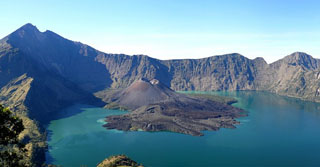Report on Rinjani (Indonesia) — 25 July-31 July 2018
Smithsonian Institution / US Geological Survey
Weekly Volcanic Activity Report, 25 July-31 July 2018
Managing Editor: Sally Sennert.
Please cite this report as:
Global Volcanism Program, 2018. Report on Rinjani (Indonesia) (Sennert, S, ed.). Weekly Volcanic Activity Report, 25 July-31 July 2018. Smithsonian Institution and US Geological Survey.
Rinjani
Indonesia
8.42°S, 116.47°E; summit elev. 3726 m
All times are local (unless otherwise noted)
PVMBG and BNPB reported that a M 6.4 earthquake was recorded at 0547 on 29 July, shaking the islands of Lombok, Bali, and Sumbawa, and causing significant damage to buildings (including collapses) and roads, ground cracks, multiple injuries, and the death of 17 people in Lombok. The hypocenter was 24 km deep, and 47 km NE of Mataram City. Aftershocks were numerous and as large as M 5.7. The earthquakes caused remobilization of ash deposits on Rinjani as well as landslides. There were 1,226 visitors to the Mount Rinjani National Park Area at the time, and, according to news articles, about 690 climbers were on the volcano and had to be rescued. One person in the national park died from rockfalls. The Alert Level remained at 2 (on a scale of 1-4); the public was warned not to approach the crater within a 1.5-km radius.
Geological Summary. Rinjani volcano on the island of Lombok rises to 3726 m, second in height among Indonesian volcanoes only to Sumatra's Kerinci volcano. Rinjani has a steep-sided conical profile when viewed from the east, but the west side of the compound volcano is truncated by the 6 x 8.5 km, oval-shaped Segara Anak (Samalas) caldera. The caldera formed during one of the largest Holocene eruptions globally in 1257 CE, which truncated Samalas stratovolcano. The western half of the caldera contains a 230-m-deep lake whose crescentic form results from growth of the post-caldera cone Barujari at the east end of the caldera. Historical eruptions dating back to 1847 have been restricted to Barujari cone and consist of moderate explosive activity and occasional lava flows that have entered Segara Anak lake.
Sources: Pusat Vulkanologi dan Mitigasi Bencana Geologi (PVMBG, also known as CVGHM), Badan Nacional Penanggulangan Bencana (BNPB), The Jakarta Post, Reuters

